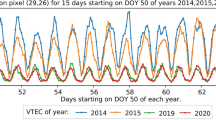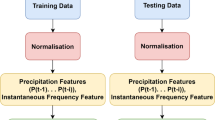Abstract
The total electron content of the ionosphere plays an important role in determining the operational conditions for various technological systems, therefore, great importance is attached to its study and forecasting. In connection with the revival of the intensive use of machine learning methods, in the first work of the authors, using the example of the reference station Juliusruh and 2015, the effectiveness of traditional models of Long Short-Term Memory (LSTM) and Gated Recurrent Unit (GRU) was studied. In this paper, in order to increase the accuracy of the forecast, several modifications of these methods were proposed: 1) implementing the proposed MidR and InR architectures based on LSTM and GRU, 2) modifying the architectures using bidirectional algorithms, 3) using the temporal convolution architecture separately and jointly with bidirectional networks, thus, defining 10 architectures under study. In addition to the previous results for an advance time of 2h, the forecast was made for the traditionally used period of 24h. It is shown that four architectures of the first group and separately TCN provide prediction accuracy at the level of literature data, and for prediction for 24h, the prediction accuracy is 2 times worse than for 2h. The inclusion of the bidirectional algorithm leads to a significant increase in the accuracy of the forecast, with the mostly comparable results for various advance times, with quantitative estimates of 0.4–0.5 TECU for MAE, 0.6–1.0 TECU for RMSE, 5–7% for MAPE. The same estimates were obtained for three stations along the 30° E meridian.
Access this chapter
Tax calculation will be finalised at checkout
Purchases are for personal use only
Similar content being viewed by others
References
Schrijver, C.J., Kauristie, K., Aylward, A.D., et al.: Understanding space weather to shield society: a global road map for 2015–2025 commissioned by COSPAR and ILWS. Adv. Space Res. 55(12), 2745–2807 (2015). https://doi.org/10.1016/j.asr.2015.03.023
McGranaghan, R.M., Camporeale, E., Georgoulis, M., Anastasiadis, A.: Space weather research in the digital age and across the full data lifecycle: introduction to the topical issue. J. Space Weather Space Clim. 11, 50 (2021). https://doi.org/10.1051/swsc/2021037
Yu, S., Ma, J.: Deep learning for geophysics: current and future trends. Rev. Geophys. 59, e2021RG000742 (2021). https://doi.org/10.1029/2021RG000742
Kalinin, Y., Repin, A., Khotenko, E.N.: Applied geophysics of the ionosphere and the actual application of artificial intelligence technology. Geliogeophys. Res. 30, 21–29 (2021). https://doi.org/10.54252/2304-7380_2021_30_21
Wang, J., Yu, Q., Shi, Y., Liu, Y., Yang, C.: An explainable dynamic prediction method for ionospheric foF2 based on machine learning. Remote Sens. 15, 1256 (2023). https://doi.org/10.3390/rs15051256
Xie, T., Dai, Z., Zhu, X., Chen, B., Ran, C.: LSTM-based short-term ionospheric TEC forecast model and positioning accuracy analysis. GPS Solutions 27, 66 (2023). https://doi.org/10.1007/s10291-023-01406-8
Nishioka, M., Saito, S., Tao, C., Shiota, D., Tsugawa, T., Ishii, M.: Statistical analysis of ionospheric total electron content (TEC): long-term estimation of extreme TEC in Japan Earth. Planets Space 73(52), 1–12 (2021). https://doi.org/10.1186/s40623-021-01374-8
Hernández-Pajares, M., et al.: The IGS VTEC maps: a reliable source of ionospheric information since 1998. J. Geod. 83, 263–275 (2009)
Badeke, R., Borries, C., Hoque, M.M., Minkwitz, D.: Empirical forecast of quiet time ionospheric total electron content maps over Europe. Adv. Space Res. 61, 2881–2890 (2018). https://doi.org/10.1016/j.asr.2018.04.010
Garcia-Rigo, A., et al.: Global prediction of the vertical total electron content of the ionosphere based on GPS data. Radio Sci. 46, RS0D25 (2011). https://doi.org/10.1029/2010RS004643
Jakowski, N., Hoque, M.M., Mayer, C.: A new global TEC model for estimating transionospheric radio wave propagation errors. J. Geod. 85, 965–974 (2011). https://doi.org/10.1007/s00190-011-0455-1
Kaselimi, M., Voulodimos, A., Doulamis, N., Doulamis, A., Delikaraoglou, D.: Deep recurrent neural networks for ionospheric variations estimation using GNSS measurements. IEEE Trans. Geosci. Remote Sens. 60, 1–15 (2022). https://doi.org/10.1109/TGRS.2021.3090856
Lin, X., et al.: A spatiotemporal network model for global ionospheric TEC forecasting. Remote Sens. 14, 1717 (2022). https://doi.org/10.3390/rs14071717
Sun, W., et al.: Forecasting of ionospheric vertical total electron content (TEC) using LSTM networks. In: Proceedings of the 2017 International Conference on Machine Learning and Cybernetics, Ningbo, China, 9–12 July 2017
Sun, W., Xu, L., Huang, X., Zhang, W., Yuan, T., Yan, Y.: Bidirectional LSTM for ionospheric vertical total electron content (TEC) forecasting. In: Proceedings of IEEE Vision and Communication Image Processing (VCIP), December 2017, pp. 1–4 (2017). https://doi.org/10.1109/VCIP.2017.8305097
Sivakrishna, K., Ratnam, D.V., Sivavaraprasad, G.: A bidirectional deep-learning algorithm to forecast regional ionospheric TEC maps. IEEE J. Sel. Top. Appl. Earth Observ. Remote Sens. 15, 4531–4543 (2022). https://doi.org/10.1109/JSTARS.2022.3180940
Tang, J., Li, Y., Ding, M., Liu, H., Yang, D., Wu, X.: An ionospheric TEC forecasting model based on a CNN-LSTM-attention mechanism neural network. Remote Sens. 14, 2433 (2022). https://doi.org/10.3390/rs14102433
Weng, J., Liu, Y., Wang, J.: A model-assisted combined machine learning method for ionospheric TEC prediction. Remote Sens. 15, 2953 (2023). https://doi.org/10.3390/rs15122953
Iluore, K., Lu, J.: Long short-term memory and gated recurrent neural networks to predict the ionospheric vertical total electron content. Adv. Space Res. 70, 652–665 (2022). https://doi.org/10.1016/j.asr.2022.04.066
Natras, R., Soja, B., Schmidt, M.: Ensemble machine learning of random forest, AdaBoost and XGBoost for vertical total electron content forecasting. Remote Sens. 14(3547), 1–34 (2022). https://doi.org/10.3390/rs14153547
Morozova, A.L., Barata, T., Barlyaeva, T.: PCA-MRM model to forecast TEC at middle latitudes. Atmosphere 13, 323 (2022). https://doi.org/10.3390/atmos13020323
Kharakhashyan, A., Maltseva, O., Glebova, G.: Forecasting the total electron content TEC of the ionosphere using space weather parameters. In: Proceedings of the 2021 IEEE International Conference on Wireless for Space and Extreme Environments (WiSEE), Cleveland, OH, USA, 12–14 October 2021, pp. 31–36 (2021). https://doi.org/10.1109/WiSEE50203.2021.9613829
Chen, J., Zhi, N., Liao, H., Lu, M., Feng, S.: Global forecasting of ionospheric vertical total electron contents via ConvLSTM with spectrum analysis. GPS Solutions 26, 69 (2022). https://doi.org/10.1007/s10291-022-01253-z
Chen, Z., Liao, W., Li, H., Wang, J., Deng, X., Hong, S.: Prediction of global ionospheric TEC based on deep learning. Space Weather 20, e2021SW002854 (2022). https://doi.org/10.1029/2021SW002854
Danilov, A.D., Konstantinova, A.V.: Detailed analysis of the behavior of the F2-layer critical frequency prior to magnetic storms. 10. Proportion between negative and positive events. Geliogeophys. Res. 35, 3–11 (2022). https://doi.org/10.5425/2304-7380_2022_35_3
Danilov, A.D., Konstantinova, A.V.: Ionospheric precursors of magnetic storms. 3. Analysis of juliusruh station data. Geomagn. Aeron. (Engl. Transl.) 61(3), 341–348 (2021). https://doi.org/10.1134/S0016793221030087
Ren, X., Yang, P., Liu, H., Chen, J., Liu, W.: Deep learning for global ionospheric TEC forecasting: different approaches and validation. Space Weather 20, e2021SW003011 (2022). https://doi.org/10.1029/2021SW003011
Hochreiter, S., Schmidhuber, J.: Long short-term memory neural computation. Neural Comput. 9(8), 1735–1780 (1997). https://doi.org/10.1162/neco.1997.9.8.1735
Cho, K., et al.: Learning phrase representations using RNN encoder-decoder for statistical machine translation. arXiv:1406.1078v3 [cs.CL] 3, (2014). https://arxiv.org/pdf/1406.1078.pdf
Glorot, X., Bengio, Y.: Understanding the difficulty of training deep feedforward neural networks. In: Proceedings of the Thirteenth International Conference on Artificial Intelligence and Statistics, Sardinia, Italy: AISTATS, pp. 249–356 (2010)
Saxe, A.M., McClelland, J.L., Ganguli, S.: Exact solutions to the nonlinear dynamics of learning in deep linear neural networks. arXiv preprint arXiv:1312.6120 (2013)
Bai, S., Kolter, J.Z., Koltun, J.V.: An empirical evaluation of generic convolutional and recurrent networks for sequence modelling, 19 April, pp. 1–14 (2018, preprint, submitted). https://arxiv.org/abs/1803.01271
Acknowledgments
The authors are grateful to the developers of websites: http://omniweb.gsfc.nasa.gov/form/dx1.html, ftp://cddis.gsfc.nasa.gov/pub/gps/products/ionex/. The research was financially supported by Ministry of Science and Higher Education of the Russian Federation (State task in the field of scientific activity 2023).
Author information
Authors and Affiliations
Corresponding author
Editor information
Editors and Affiliations
Rights and permissions
Copyright information
© 2023 The Author(s), under exclusive license to Springer Nature Switzerland AG
About this paper
Cite this paper
Maltseva, O.A., Kharakhashyan, A.M. (2023). Influence of Advance Time on Accuracy of the Ionospheric Total Electron Content Forecast. In: Shishkov, B., Lazarov, A. (eds) Telecommunications and Remote Sensing. ICTRS 2023. Communications in Computer and Information Science, vol 1990. Springer, Cham. https://doi.org/10.1007/978-3-031-49263-1_3
Download citation
DOI: https://doi.org/10.1007/978-3-031-49263-1_3
Published:
Publisher Name: Springer, Cham
Print ISBN: 978-3-031-49262-4
Online ISBN: 978-3-031-49263-1
eBook Packages: Computer ScienceComputer Science (R0)




